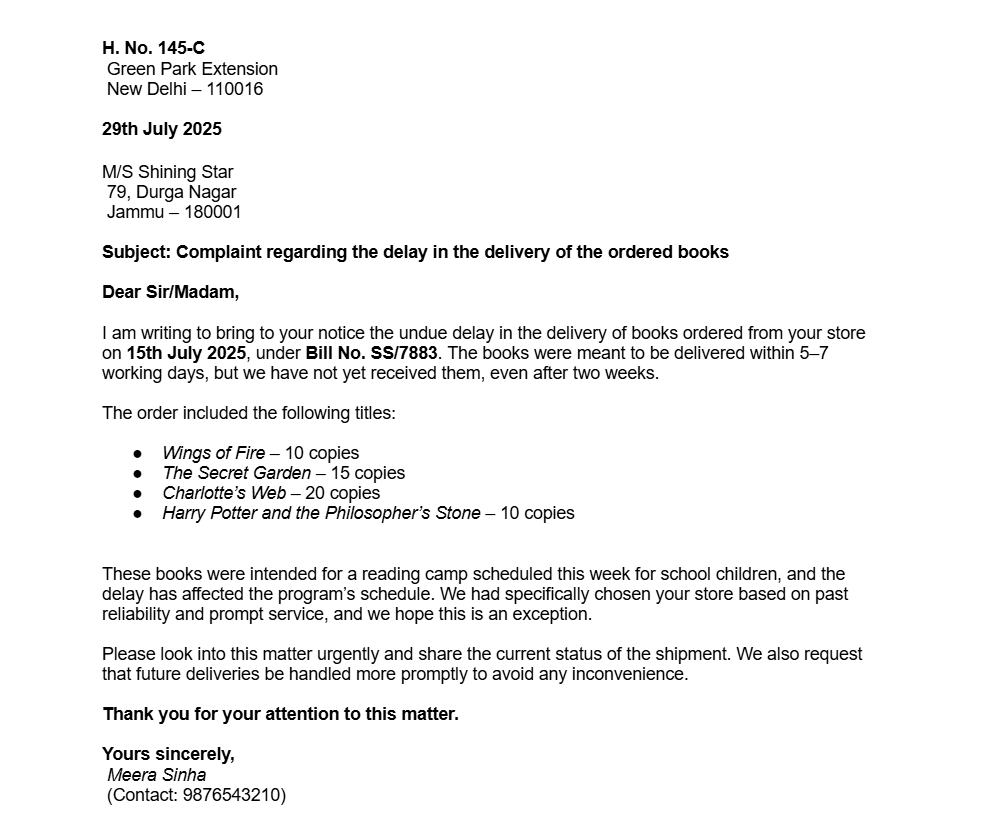Complaint Letter Format
Have you ever faced problems with serving cold food in your school canteen, faulty lab equipment, or a broken classroom fan? Did you notice poor maintenance, negligence, or any other issues in your surroundings? In many such cases, people choose to stay silent, and the problem remains unresolved and continues to affect others.
One of the most effective and formal ways to raise your voice and bring such issues to the attention of the concerned authorities is by writing a complaint letter. A complaint letter helps express dissatisfaction, seek corrective action, and promote accountability. Whether it's a faulty product, poor service, or a public issue, writing a well-structured complaint letter can help ensure that your concerns are taken seriously and acted upon.
Understanding the correct format of a complaint letter is important, especially for students, as it teaches them how to communicate their concerns formally and responsibly. In the following section, we will get deep into how to structure and write a complaint letter effectively.
Table of Contents
- What Is a Complaint Letter?
- How to Write a Complaint Letter Format
- Tips for Writing an Effective Complaint Letter
- Complaint Letter Samples
- Frequently Asked Questions on Complaint Letter
What Is a Complaint Letter?
A complaint letter is a formal letter written to express dissatisfaction or raise a concern about something unfair, inconvenient, or not working properly. It is a fundamental right of a citizen to seek justice arising from any injustice, and the first step toward this is filing a Complaint. It helps inform the responsible authorities, such as school staff, municipal officers, or company representatives, about issues that may otherwise go unnoticed. For students, complaint letters can be a powerful tool to address academic or campus-related concerns in a respectful and effective way.
Writing a complaint letter shows that you are aware of your rights and responsibilities. It helps bring problems to the attention of the concerned people, so they can fix them. A good complaint letter is clear, polite, and to the point.
Here, you’ll learn how to write an effective complaint letter and see examples that relate to real-life situations students often face.
How to Write a Complaint Letter Format
Complaint letters are written to the appropriate authorities when you are dissatisfied with a service or have a problem that needs to be resolved. A complaint letter should be written in the same structure as a formal letter; nevertheless, do not forget to be polite. To compose a complaint letter, begin with the sender's address, then the date, the recipient's address, the subject, salutation, body of the letter, complimentary closing, signature, and name.
Students should follow the guide below to gain a thorough understanding of the process of creating a complaint letter, including what should be written where.
SENDER'S ADDRESS- The sender's address is typically displayed in the top left corner of the page.
DATE- The sender's address is followed by the date, which appears directly below it on the left side of the page. This is the date on which the letter is written. It should be written in extended form.
RECEIVER'S ADDRESS- It is up to the writer whether to include "To" above the address. Make sure the first line of the address includes the receiving official's title/name/position, etc.
SALUTATIONS - This is where you greet the person to whom the letter is addressed. Keep in mind that this is an official letter, so the greeting should be respectful but not overly personal. Formal letters utilise the usual greetings "Sir" or "Madam".
SUBJECT- Finally, we summarise the purpose of the message in one line. This allows the recipient to focus on the subject of the message at a glance. It is critical to highlight the subject.
BODY- This is the main content of the letter. It is either divided into three paragraphs or two paragraphs if the letter is briefer. The tone of the content should be formal. Do not use any offensive language. Another point to be kept in mind is that the letter should be concise and to the point. And always be respectful and considerate in your language. It should include-
-
Short introduction paragraph- Provide details about the product or service that is the subject of the complaint. Include dates, location, and the specifications about the item or service.
-
State the issue with the item or service. Provide details as to the cause. This may include malfunction, billing issues, details that were not disclosed, etc.
-
Indicate how you would like them to resolve your problem. Provide specifics about what you’re seeking.
-
Indicate that you are including copies of the transaction document.
-
Indicate that you look forward to their reply within a specific time.
-
Indicate that they can contact you about the issue and provide your contact details
COMPLIMENTARY CLOSE- At the end of your letter, we include a complimentary closure. The terms "Yours Faithfully" and "Yours Sincerely" are used.
SIGNATURE- Finally, sign your name. Next, write your name in block letters beneath the signature, followed by your designation. This is how the receiver will know who sent the letter.
Tips for Writing an Effective Complaint Letter
Start your letter politely
Manners are highly important. Cordial letters (warm, friendly, gracious, or sincere) are more likely to be received and read. Letters containing threats and all uppercase, on the other hand, receive the bare minimum of response. Or not at all.
If your letter contains profanity, it will most likely be ignored, and those that are deemed threatening will be turned over to law enforcement. The most effective e-mails and letters are short, averaging only 500 words. They offer all of the information needed to track your situation.
Ask a question
Your request should be formatted as a question. The query should be along the lines of "How do you fix this?" State exactly what you want done and how long you're willing to wait for a response. Another common phrase pattern is "I wish to complain in the strongest terms about". The question should be straightforward to understand. It also helps if it is genuine and without sarcasm.
Explain the problem
You should mention your motive for writing the letter. Highlight the facts, such as the time, date, and location of your transaction or receipt of services. The reader should be able to get the point on reading the first few sentences; hence, it is important not to beat about the bush. Explain yourself well and be detailed to capture the reader’s attention.
Don't blame the individual you're dealing with
It is important that you maintain a courteous tone throughout your letter. No matter how justified your complaint is, your letter should not become angry, sarcastic, or threatening. Keep in mind that the individual who receives your letter is often not the person who actually caused the problem.
Show them you are in the know
If you can convince the company that it did not follow its own standards or disobeyed the law, your complaint will have a better chance of being heard. If your complaint letter does not result in the desired effects, consider writing another letter in a firmer tone or writing to someone higher up in the chain of command.
Complaint Letter Samples
A complaint letter format will typically start with the sender's information, followed by mentioning who it's addressed to, the date, and then the letter itself. The opening paragraph should state your reason for writing, and the core of the subject will go into detail about the matter. At the end of the letter, make it clear what you hope to achieve, and politely sign off.
Here are a few complaint letter samples to help you understand the format of the complaint letter and help you write a complaint letter on your own.
Complaint Letter Sample 1 – Poor Maintenance of the Garden and Improper Waste Disposal
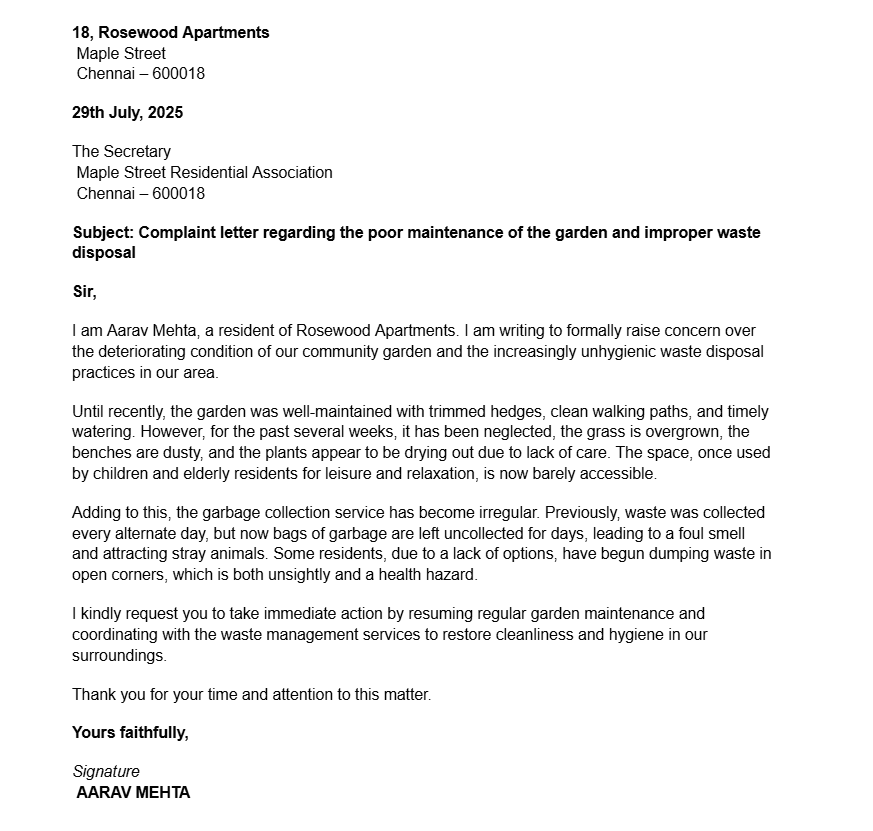
Complaint Letter Sample 2 – Damaged Product Received
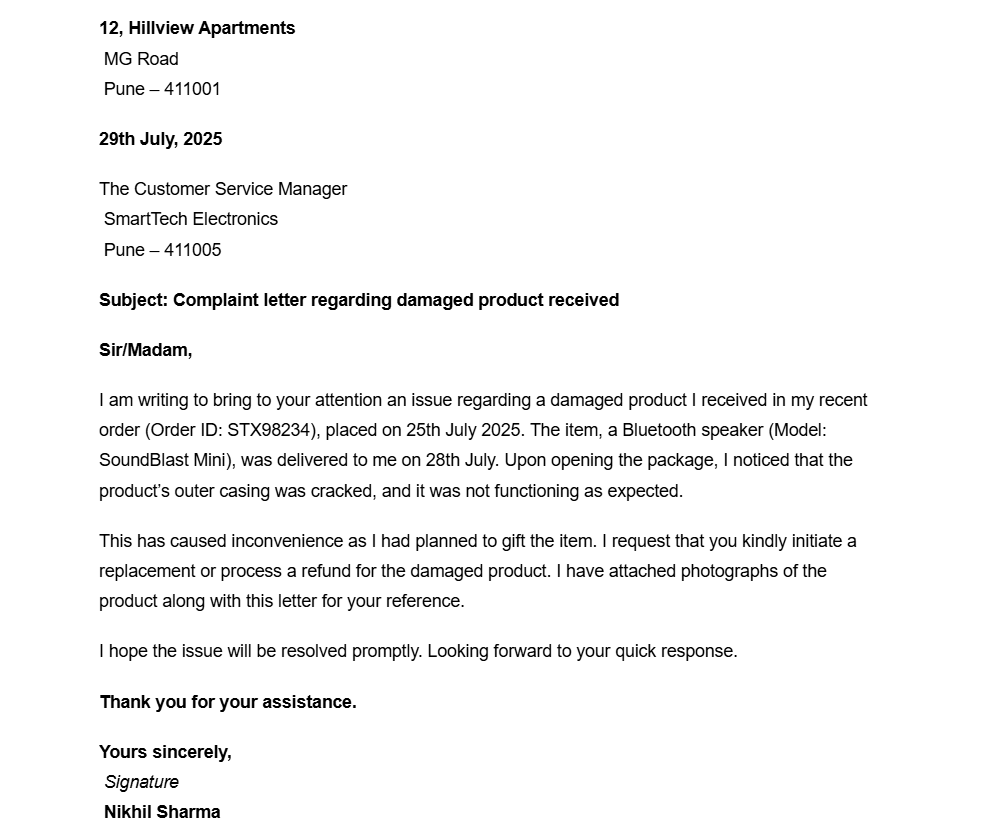
Complaint Letter Sample 3 – Installation of New Street Lights
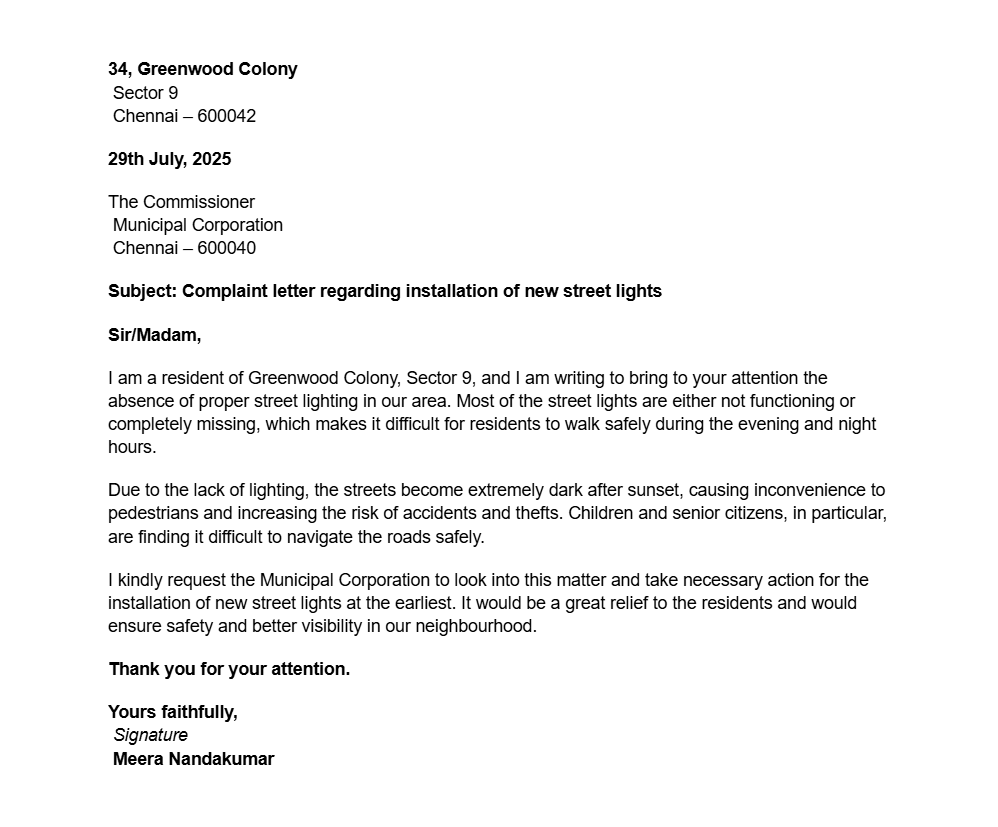
Complaint Letter Sample 4 – Poor Quality of Food in the Canteen

Complaint Letter Sample 5 – Unsanitary Conditions in the Colony
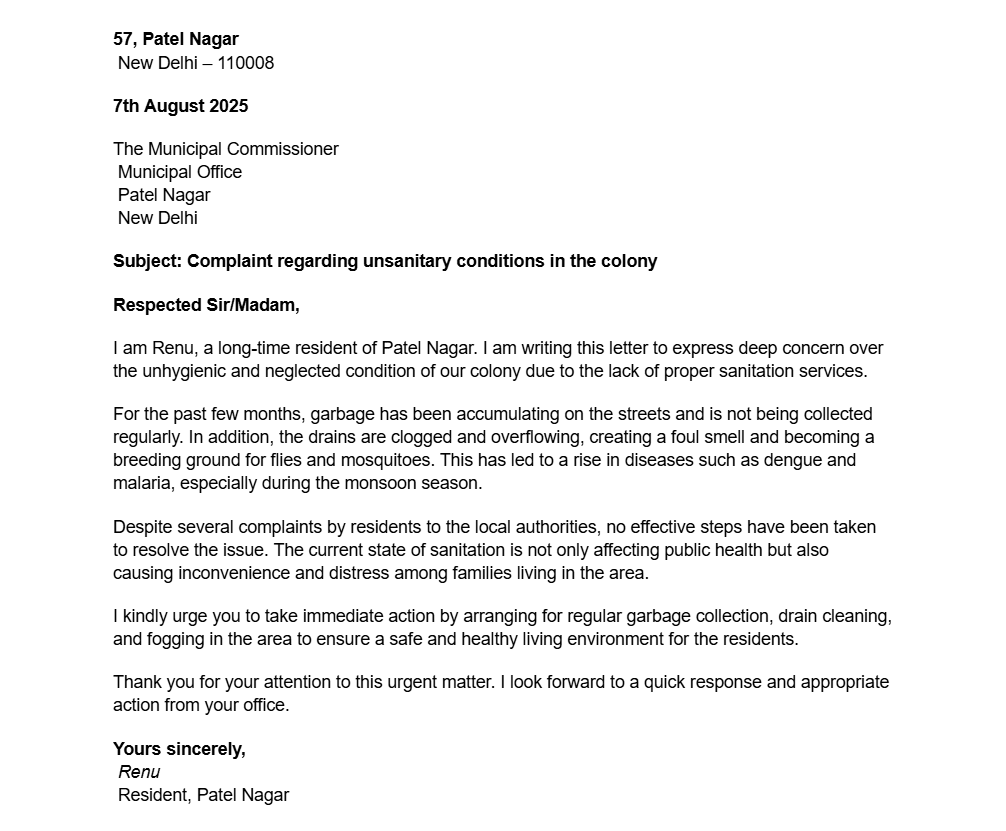
Complaint Letter Sample 6 – Non-Availability of NCERT Textbooks
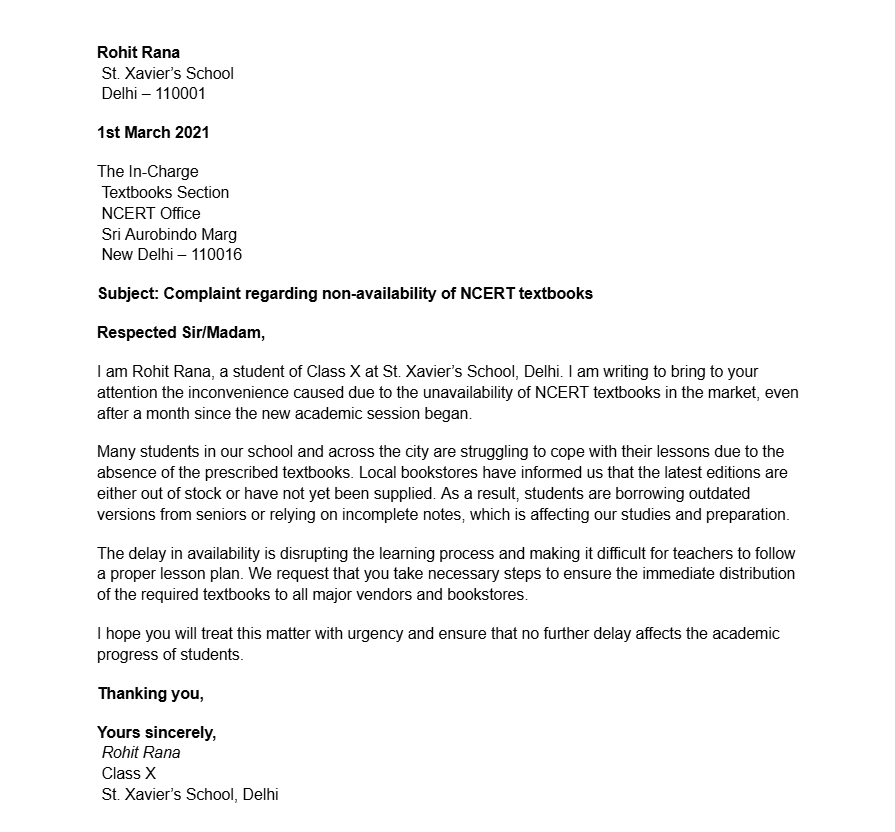
Complaint Letter Sample 7 – Delay in the delivery of books
Complaint Letter Sample 8 – Regarding Teacher’s Behaviour in Class
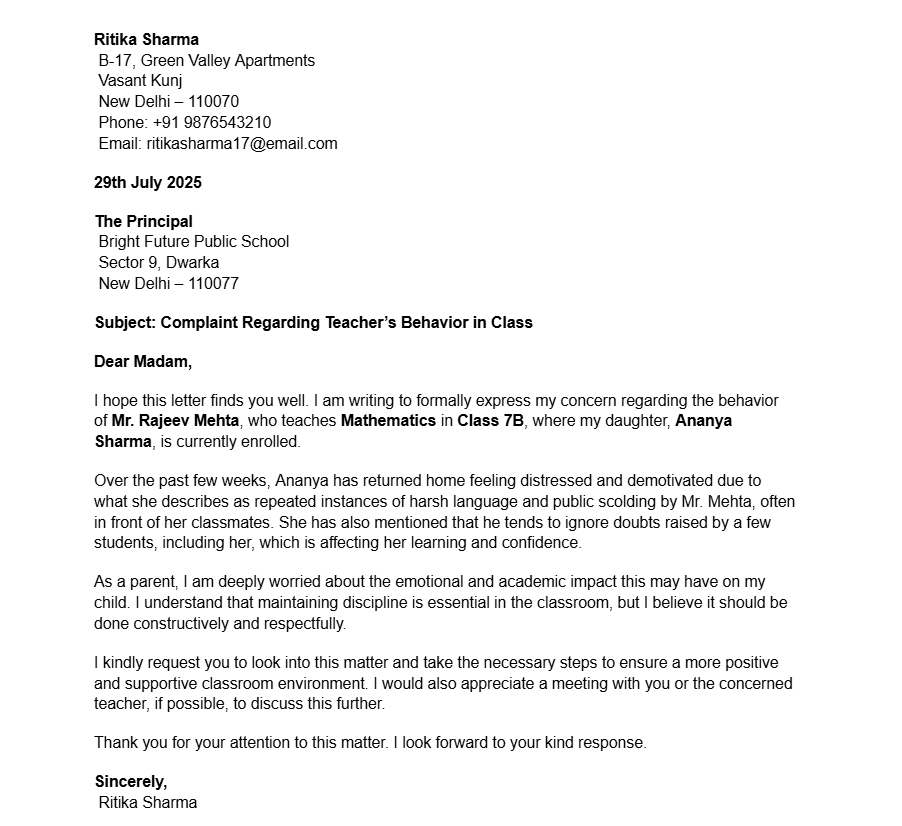
Complaint Letter Sample 9 – Poor Condition of Campus Facilities
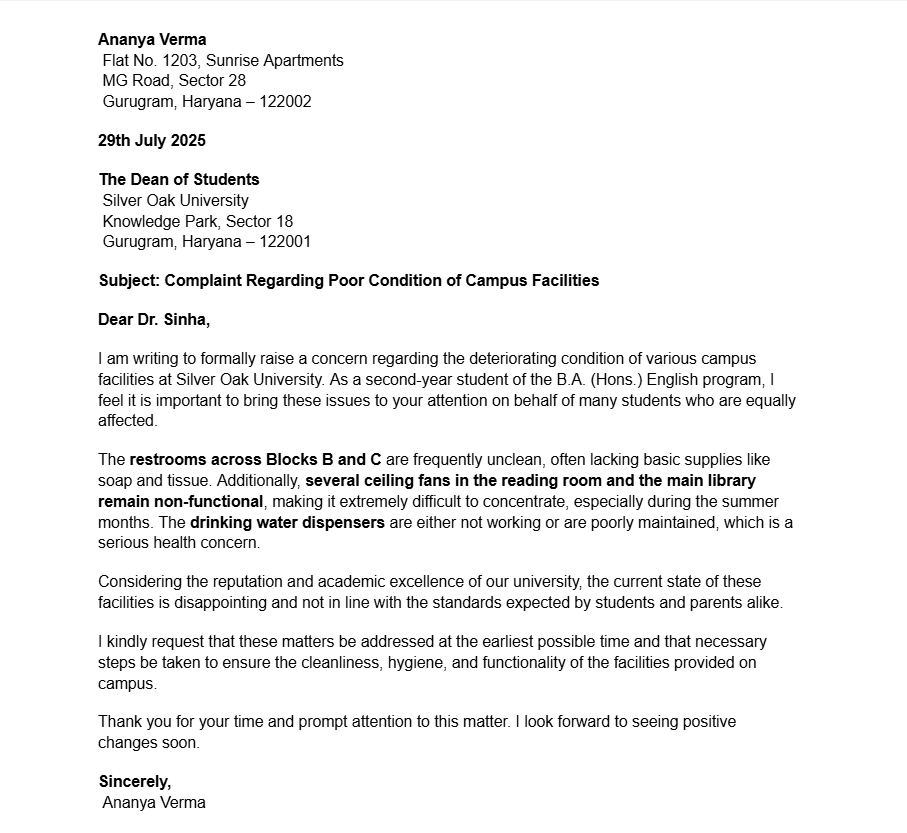
Complaint Letter Sample 10 – Regarding Delay in Delivery of Order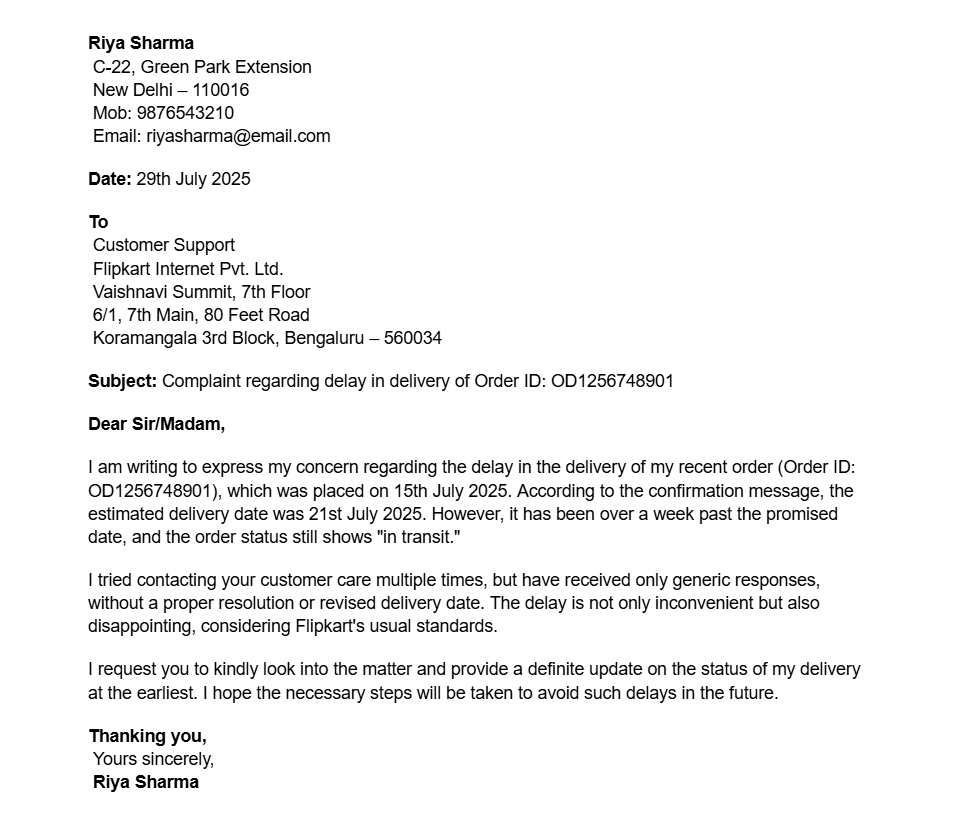
Complaint Letter Sample 12: Regarding a Bogus Doctor Operating in Delhi
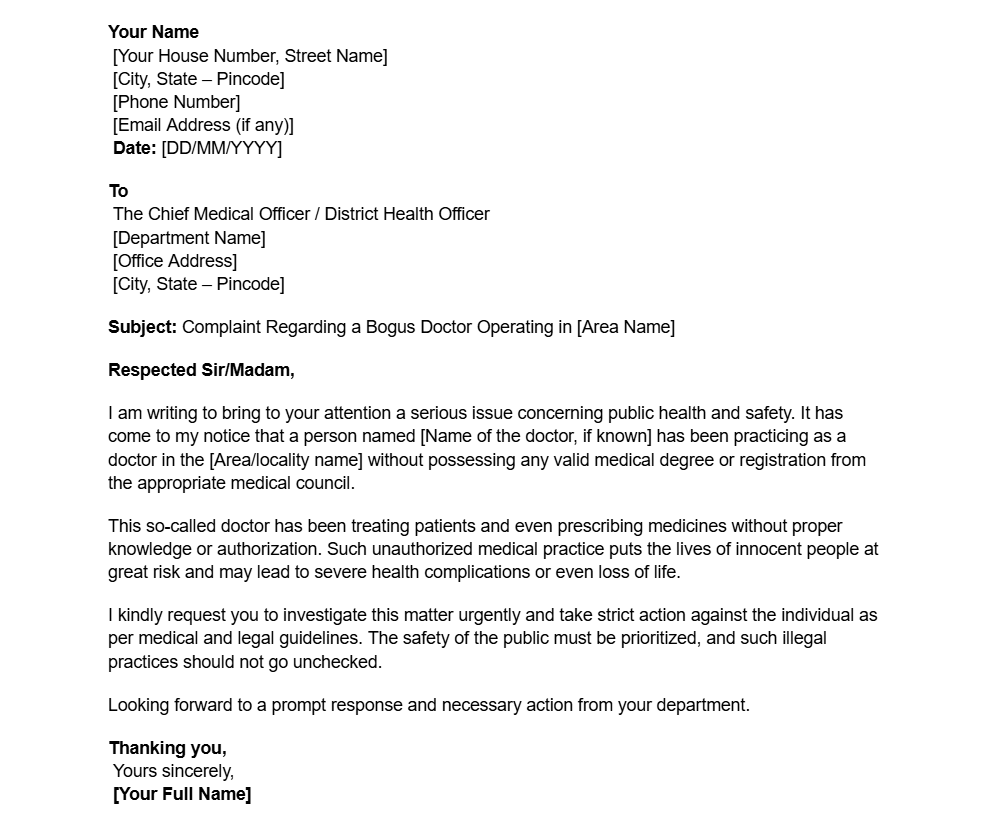
Frequently Asked Questions on Complaint Letter
Q1. How to write a complaint letter for class 10th?
Answer: For Class 10 exams, focus on a clear and concise formal letter structure. Begin with your address and the date, followed by the recipient's address and a subject line summarising your complaint. Use a formal salutation like “Dear Sir/Madam.” Clearly state your complaint with specific details and supporting evidence.
Q2. What is an official letter of complaint?
Answer: A complaint Letter is a written communication used to raise your concerns with a product, service, or to address other types of grievances. The purpose of the letter is to address the problem and seek a productive resolution.
Q3. What is the main objective of a complaint letter?
Answer: A complaint letter is written by a customer to an individual or organisation in response to a problem or complaint that has arisen. The purpose of the letter is to state the grievance, request action to be taken to resolve the situation, and keep records of the complaint for future reference
Q4. What is the most common type of complaint?
Answer: The most common complaints include:
-
Costs: the costs were unclear or different from the original estimate.
-
Delay: no clear reason for the work taking longer than expected.
-
Poor information: a process wasn't well explained, or there wasn't enough information for a consumer to make an informed choice.
Q5. What are the characteristics of a complaint letter?
Answer: Maintain a firm but respectful tone, and avoid aggressive, accusing language. Keep the tone of your complaint letter professional. The person you are dealing with might not be directly responsible for the problem, and will be more likely to help you if he or she sympathises with you.
Admissions Open for
Admissions Open for
CBSE Schools In Popular Cities
- CBSE Schools in Bangalore
- CBSE Schools in Mumbai
- CBSE Schools in Pune
- CBSE Schools in Hyderabad
- CBSE Schools in Chennai
- CBSE Schools in Gurgaon
- CBSE Schools in Kolkata
- CBSE Schools in Indore
- CBSE Schools in Sonipat
- CBSE Schools in Delhi
- CBSE Schools in Rohtak
- CBSE Schools in Bhopal
- CBSE Schools in Aurangabad
- CBSE Schools in Jabalpur
- CBSE Schools in Jaipur
- CBSE Schools in Jodhpur
- CBSE Schools in Nagpur
- CBSE Schools in Ahmednagar
- CBSE School In Tumkur

